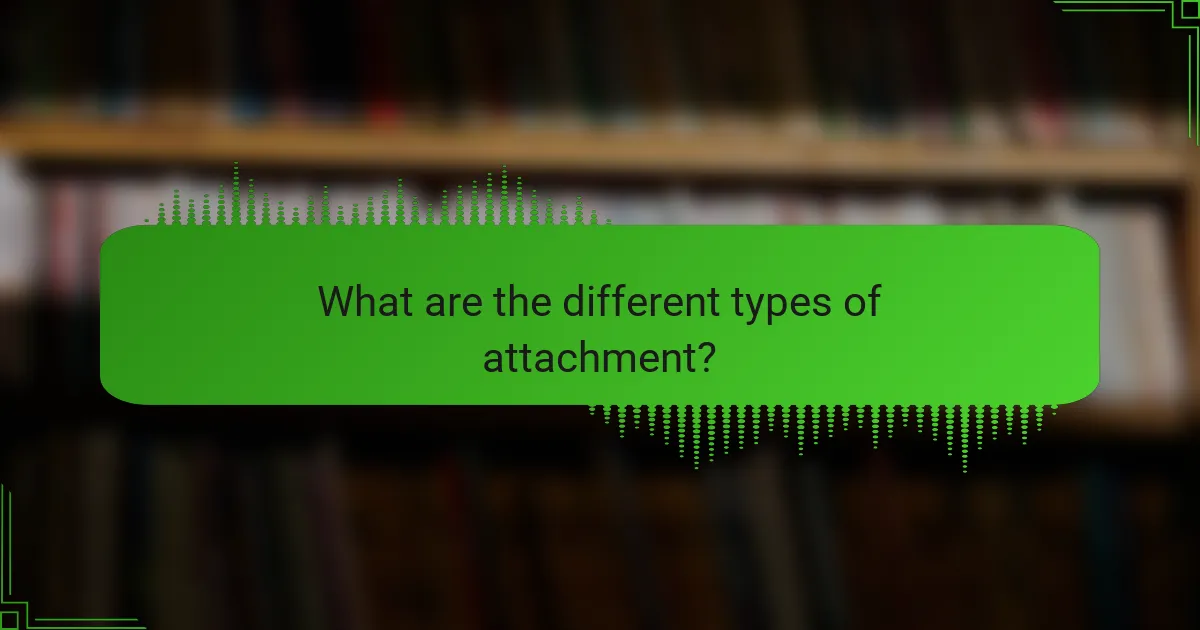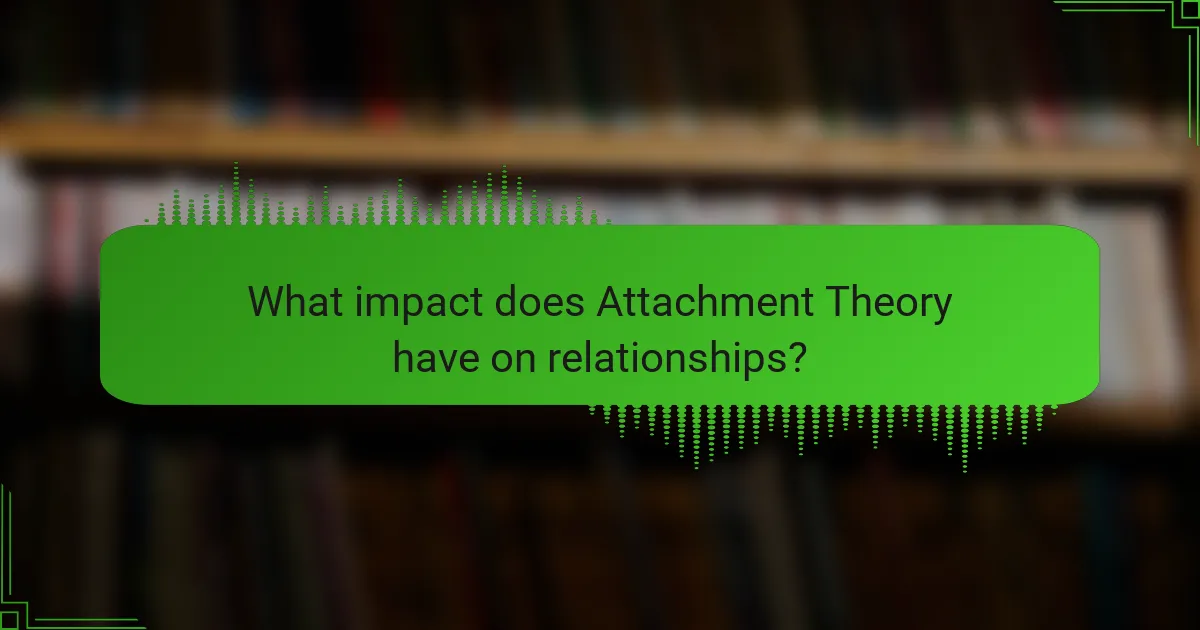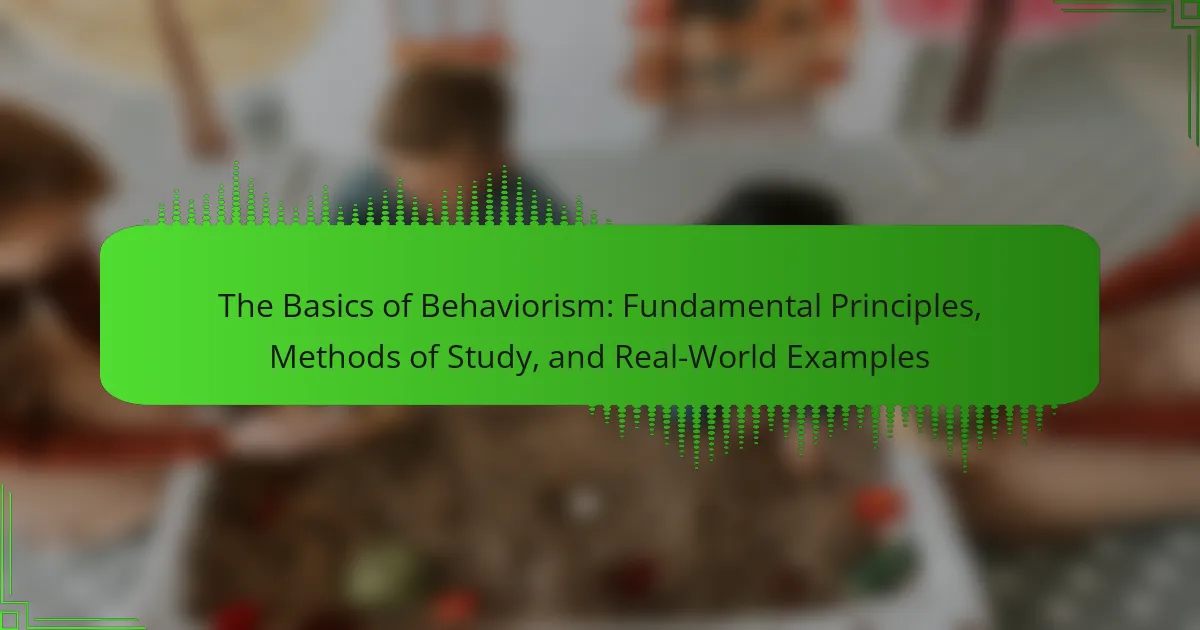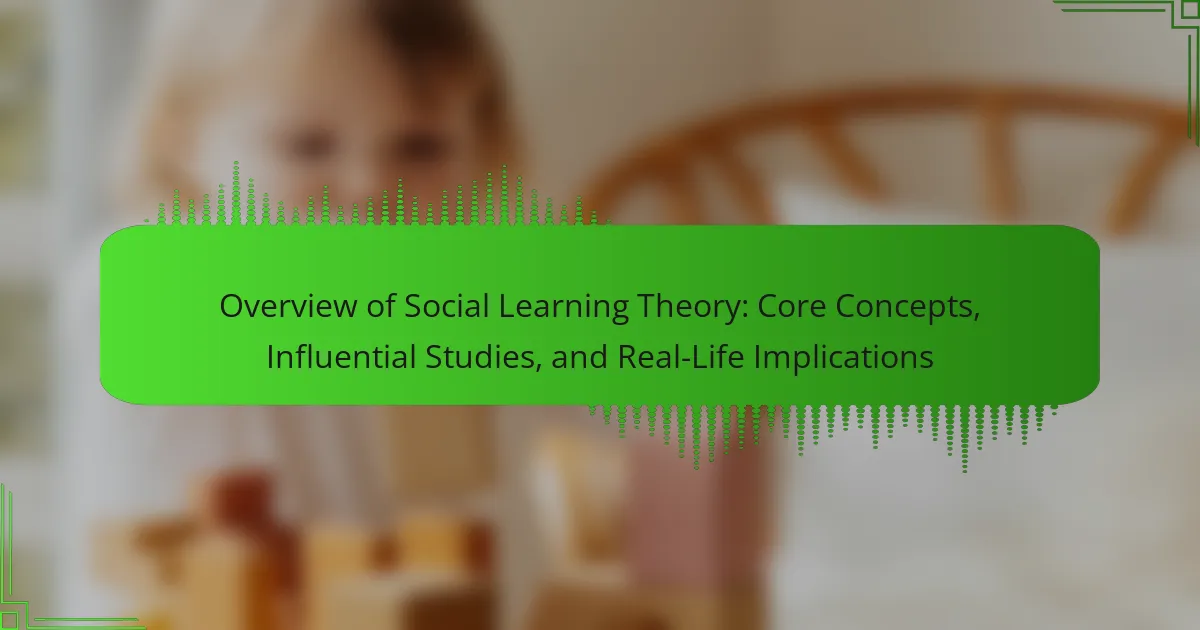Attachment Theory is a psychological model that examines the dynamics of long-term interpersonal relationships, developed by John Bowlby in the 1950s. The theory emphasizes how early relationships with caregivers influence an individual’s emotional and social development, leading to different attachment styles: secure, anxious, avoidant, and disorganized. Secure attachment is associated with healthier adult relationships, while insecure attachment styles can lead to challenges in intimacy and conflict resolution. This overview will explore the key concepts of Attachment Theory, the characteristics of each attachment style, and their significant impact on interpersonal relationships and emotional well-being. Research findings will highlight how attachment styles can evolve over time through positive relational experiences.

What is Attachment Theory?
Attachment Theory is a psychological model that describes the dynamics of long-term interpersonal relationships. It was developed by John Bowlby in the 1950s. The theory posits that early relationships with caregivers shape an individual’s emotional and social development. Secure attachment leads to healthier relationships in adulthood. In contrast, insecure attachment can result in difficulties in relationships. Research shows that attachment styles influence behaviors and expectations in romantic relationships. Studies indicate that secure individuals are more likely to communicate effectively and resolve conflicts. Attachment Theory has been widely applied in various fields, including psychology, counseling, and social work.
How did Attachment Theory originate?
Attachment Theory originated from the work of John Bowlby in the mid-20th century. Bowlby was a British psychologist who studied the bond between infants and their primary caregivers. His research was influenced by psychoanalytic concepts and ethological studies of animal behavior. Bowlby proposed that the attachment system was biologically programmed to enhance survival. He observed that children who experienced separation from their caregivers exhibited distress and anxiety. This led to the formulation of attachment styles based on patterns of behavior in relationships. Mary Ainsworth further expanded Bowlby’s work through her “Strange Situation” study. This study identified different attachment styles in children, including secure, anxious, and avoidant attachments. The findings of Bowlby and Ainsworth laid the foundation for understanding emotional bonds in human relationships.
Who were the key figures in the development of Attachment Theory?
John Bowlby and Mary Ainsworth were the key figures in the development of Attachment Theory. John Bowlby is known for formulating the initial concepts of attachment. He emphasized the importance of the bond between a child and their caregiver. His work laid the foundation for understanding the emotional ties in early development. Mary Ainsworth expanded on Bowlby’s ideas through her empirical research. She developed the “Strange Situation” procedure to observe attachment behaviors in infants. Ainsworth identified different attachment styles: secure, anxious, and avoidant. Their combined contributions established Attachment Theory as a crucial framework in developmental psychology.
What research studies contributed to the understanding of Attachment Theory?
The research studies that contributed to the understanding of Attachment Theory include John Bowlby’s work and Mary Ainsworth’s Strange Situation. John Bowlby developed the foundational concepts of Attachment Theory in the 1950s. He emphasized the importance of early relationships between children and caregivers. His study outlined the impact of attachment on emotional and social development.
Mary Ainsworth expanded on Bowlby’s theories in the 1970s. She conducted the Strange Situation experiment to observe attachment behaviors in infants. This research identified different attachment styles: secure, anxious, and avoidant. Ainsworth’s findings provided empirical evidence supporting Bowlby’s theoretical framework.
Subsequent studies have further explored attachment across the lifespan. Research by Main and Solomon introduced the concept of disorganized attachment in the 1980s. These studies collectively enhanced the understanding of how early attachment experiences shape personality and relationships in adulthood.
What are the key concepts of Attachment Theory?
Attachment Theory focuses on the emotional bonds between individuals, particularly between children and their caregivers. Key concepts include secure attachment, anxious attachment, and avoidant attachment. Secure attachment develops when caregivers are responsive and consistent. Anxious attachment arises from inconsistent caregiving, leading to clinginess. Avoidant attachment results from caregivers who are emotionally unavailable, fostering independence. These attachment styles influence interpersonal relationships throughout life. Research by Mary Ainsworth and John Bowlby established these concepts. Their studies demonstrated how early attachment experiences shape emotional and social development.
What is the definition of attachment in psychological terms?
Attachment in psychological terms refers to the emotional bond that develops between individuals, particularly between a caregiver and a child. This bond is crucial for the child’s development and influences their future relationships. Attachment theory, developed by John Bowlby, posits that early interactions with caregivers shape an individual’s ability to form secure relationships later in life. Research shows that secure attachment leads to healthier interpersonal relationships, while insecure attachment can result in difficulties in emotional regulation and relationship building.
How does attachment influence emotional development?
Attachment significantly influences emotional development by shaping how individuals form relationships and manage emotions. Secure attachment leads to better emotional regulation and resilience. In contrast, insecure attachment can result in difficulties with trust and emotional expression. Research indicates that children with secure attachments are more likely to develop healthy social skills. These children often display higher levels of empathy and lower levels of anxiety. Studies show that early attachment experiences can predict emotional outcomes in adulthood. For example, individuals with secure attachments tend to have more satisfying relationships. This correlation underscores the importance of early bonding experiences in emotional growth.

What are the different types of attachment?
There are four main types of attachment: secure, anxious, avoidant, and disorganized. Secure attachment is characterized by comfort with intimacy and a strong sense of self. Anxious attachment involves a preoccupation with relationships and a fear of abandonment. Avoidant attachment is marked by a reluctance to depend on others and a preference for emotional distance. Disorganized attachment combines elements of both anxious and avoidant styles, often resulting from trauma or inconsistent caregiving. These attachment styles are foundational in understanding interpersonal relationships and emotional health. Research by Mary Ainsworth and others has validated these categories through observational studies and assessments of child-caregiver interactions.
What are the main attachment styles identified in Attachment Theory?
The main attachment styles identified in Attachment Theory are secure, anxious, avoidant, and disorganized. Secure attachment is characterized by comfort with intimacy and independence. Anxious attachment involves a preoccupation with relationships and fear of abandonment. Avoidant attachment is marked by a reluctance to depend on others and a tendency to distance oneself emotionally. Disorganized attachment combines elements of both anxious and avoidant styles, often resulting from traumatic experiences. These styles influence interpersonal relationships and emotional regulation throughout life.
What characterizes secure attachment?
Secure attachment is characterized by a strong emotional bond between a child and caregiver. This bond fosters trust and a sense of safety. Children with secure attachment feel comfortable exploring their environment. They seek comfort from their caregiver when distressed. They also show a healthy balance between independence and dependence. Research shows that secure attachment leads to better emotional regulation. It is linked to positive social relationships in adulthood. Studies indicate that securely attached individuals tend to have higher self-esteem and lower anxiety.
How does anxious attachment manifest in relationships?
Anxious attachment manifests in relationships through a constant need for reassurance and validation. Individuals with this attachment style often fear abandonment. They may exhibit clingy behavior, seeking excessive closeness. This can lead to heightened sensitivity to their partner’s moods. They may misinterpret neutral or ambiguous signals as negative. Such individuals often experience emotional highs and lows based on their partner’s responses. Research indicates that anxious attachment is linked to lower relationship satisfaction. A study by Mikulincer and Shaver (2007) highlights that anxious individuals may struggle with trust and intimacy.
What are the traits of avoidant attachment?
Avoidant attachment is characterized by a reluctance to rely on others. Individuals with this attachment style often value independence over intimacy. They may avoid emotional closeness and struggle with vulnerability. These individuals typically suppress their feelings and may appear distant or aloof. They often prioritize self-sufficiency and may feel uncomfortable with dependency. Avoidant individuals may also have difficulty expressing their emotions. Research indicates that this attachment style can stem from early experiences with caregivers who were emotionally unavailable. This pattern can impact relationships negatively, leading to challenges in forming secure connections.
What is disorganized attachment and how does it differ from other styles?
Disorganized attachment is a type of insecure attachment characterized by a lack of clear attachment behavior. Children with disorganized attachment often display contradictory behaviors towards their caregivers. They may approach the caregiver but then freeze or avoid them. This style typically arises from inconsistent or frightening caregiving experiences. Unlike secure attachment, which fosters trust and safety, disorganized attachment leads to confusion and anxiety in relationships. In contrast to avoidant and anxious attachment styles, which exhibit more predictable patterns, disorganized attachment is marked by unpredictability. Research shows that disorganized attachment is linked to higher risks of emotional and behavioral issues later in life.
How do attachment styles develop in childhood?
Attachment styles develop in childhood primarily through interactions with caregivers. These interactions shape a child’s perceptions of trust and security. Consistent and responsive caregiving fosters secure attachment. In contrast, inconsistent or neglectful caregiving can lead to insecure attachment styles. Research shows that children observe and internalize their caregivers’ behaviors. For example, a study by Ainsworth in the 1970s identified different attachment styles based on caregiver responsiveness. Securely attached children tend to explore their environment confidently. Insecurely attached children often exhibit anxiety or avoidance in relationships. These early experiences significantly influence future relational patterns.
What role do caregivers play in shaping attachment styles?
Caregivers play a crucial role in shaping attachment styles. They provide the primary emotional support and security that children need. Consistent and responsive caregiving typically leads to secure attachment. In contrast, inconsistent or neglectful caregiving can foster insecure attachment styles. Research indicates that children with secure attachments often display better emotional regulation. A study by Ainsworth et al. (1978) demonstrated the impact of caregiver responsiveness on attachment security. This evidence underscores the importance of caregiver behavior in forming attachment styles.
How does early childhood experience affect [censured] relationships?
Early childhood experiences significantly shape [censured] relationships. These experiences influence attachment styles developed during formative years. Secure attachments foster healthy relationships in adulthood. In contrast, insecure attachments can lead to difficulties in trust and intimacy. Research indicates that individuals with secure attachments tend to have more satisfying relationships. They communicate effectively and resolve conflicts constructively. Conversely, those with anxious or avoidant attachments may struggle with emotional regulation. This can result in patterns of dependency or withdrawal in [censured] relationships. Studies, such as those by Bowlby and Ainsworth, support these findings through extensive observational research.

What impact does Attachment Theory have on relationships?
Attachment Theory significantly influences relationships by shaping emotional bonds and interaction patterns. It categorizes attachment styles into secure, anxious, avoidant, and disorganized. Secure attachment fosters trust and effective communication. Anxious attachment may lead to dependency and fear of abandonment. Avoidant attachment often results in emotional distance and difficulty in intimacy. Disorganized attachment can cause confusion and erratic behaviors in relationships. Research shows that individuals with secure attachment tend to have healthier, more stable relationships. In contrast, those with insecure attachment styles often struggle with conflicts and relationship satisfaction. Studies indicate that attachment styles can be modified over time through positive relationship experiences.
How do attachment styles affect romantic relationships?
Attachment styles significantly influence romantic relationships. They shape how individuals connect, communicate, and respond to each other. Secure attachment typically leads to healthier relationships. Individuals with this style are comfortable with intimacy and trust. Anxious attachment may cause clinginess and fear of abandonment. This can result in heightened emotional responses during conflicts. Avoidant attachment often leads to emotional distance and difficulty in expressing feelings. Such individuals may struggle with commitment and intimacy. Research indicates that these styles can predict relationship satisfaction and stability. For example, a study by Fraley and Shaver (2000) found that secure individuals report higher relationship satisfaction.
What challenges do individuals with insecure attachment face in relationships?
Individuals with insecure attachment face significant challenges in relationships. They often struggle with trust and intimacy. This leads to difficulties in forming deep connections. Insecure attachment can cause anxiety about abandonment. It may also result in clinginess or avoidance of closeness. Communication issues frequently arise due to fear of vulnerability. These individuals may misinterpret partner behaviors, leading to conflict. Research indicates that insecure attachment correlates with relationship dissatisfaction. A study by Mikulincer and Shaver (2007) highlights these patterns in [censured] relationships.
How can understanding attachment styles improve relationship dynamics?
Understanding attachment styles can significantly improve relationship dynamics. Attachment styles, which are patterns of behavior in relationships, influence how individuals connect with others. Recognizing one’s own attachment style helps individuals understand their emotional responses and needs. It also allows partners to identify their differences and work towards better communication. Research indicates that secure attachment leads to healthier relationships, while insecure attachment can cause conflicts. By fostering secure attachments, couples can enhance trust and intimacy. This understanding can reduce misunderstandings and promote empathy between partners. Overall, awareness of attachment styles facilitates personal growth and relationship satisfaction.
What are the implications of Attachment Theory in therapy and counseling?
Attachment Theory provides a framework for understanding client behaviors and emotions in therapy. It emphasizes the role of early relationships in shaping an individual’s emotional and relational patterns. Therapists use this theory to identify attachment styles, such as secure, anxious, or avoidant. Recognizing these styles helps in tailoring therapeutic approaches to individual needs.
For instance, clients with anxious attachment may require reassurance and validation. Those with avoidant attachment might benefit from strategies that encourage emotional expression. Research shows that incorporating Attachment Theory into therapy enhances rapport and trust between therapist and client. A study by Mikulincer and Shaver (2007) found that understanding attachment styles can improve therapeutic outcomes. Thus, Attachment Theory significantly influences therapy and counseling practices.
How can therapists use Attachment Theory to help clients?
Therapists can use Attachment Theory to help clients by identifying their attachment styles. Understanding whether a client has a secure, anxious, or avoidant attachment style is crucial. This identification can inform therapeutic approaches. For instance, clients with insecure attachment may benefit from developing trust and emotional regulation skills. Therapists can create a safe space for clients to explore their feelings and relationships. This exploration can lead to insights about past experiences and current behaviors. Additionally, therapists can teach clients healthier relationship patterns based on their attachment styles. Research indicates that addressing attachment issues can improve emotional well-being and relationship satisfaction. By integrating Attachment Theory into therapy, therapists can provide tailored support that addresses clients’ unique relational needs.
What techniques are effective in addressing attachment-related issues?
Effective techniques for addressing attachment-related issues include cognitive-behavioral therapy (CBT), attachment-based therapy, and mindfulness practices. CBT helps individuals identify and change negative thought patterns related to attachment. Attachment-based therapy focuses on improving relationships and emotional connections through understanding attachment styles. Mindfulness practices promote self-awareness and emotional regulation, which can enhance attachment security. Research indicates that these techniques can lead to improved emotional well-being and healthier relationships. For example, a study published in the Journal of Counseling Psychology found that CBT significantly reduced anxiety related to attachment.
What practical steps can individuals take to improve their attachment style?
Individuals can improve their attachment style by engaging in self-reflection. Self-reflection helps identify personal patterns in relationships. Journaling about feelings and experiences can enhance this process. Seeking therapy or counseling provides professional support for deeper understanding. Therapists can offer strategies tailored to individual needs. Practicing mindfulness promotes awareness of emotional responses. Mindfulness techniques can reduce anxiety and improve emotional regulation. Building healthy relationships with secure individuals fosters positive attachment experiences. Observing and learning from secure attachments can reshape personal attachment styles.
Attachment Theory is a psychological model that explores the dynamics of long-term interpersonal relationships, emphasizing how early interactions with caregivers shape emotional and social development. The article covers the origins of Attachment Theory, key figures like John Bowlby and Mary Ainsworth, and the classification of attachment styles: secure, anxious, avoidant, and disorganized. It examines how these styles influence [censured] relationships, emotional regulation, and the implications for therapy and counseling, highlighting techniques for addressing attachment-related issues and practical steps individuals can take to improve their attachment styles.



